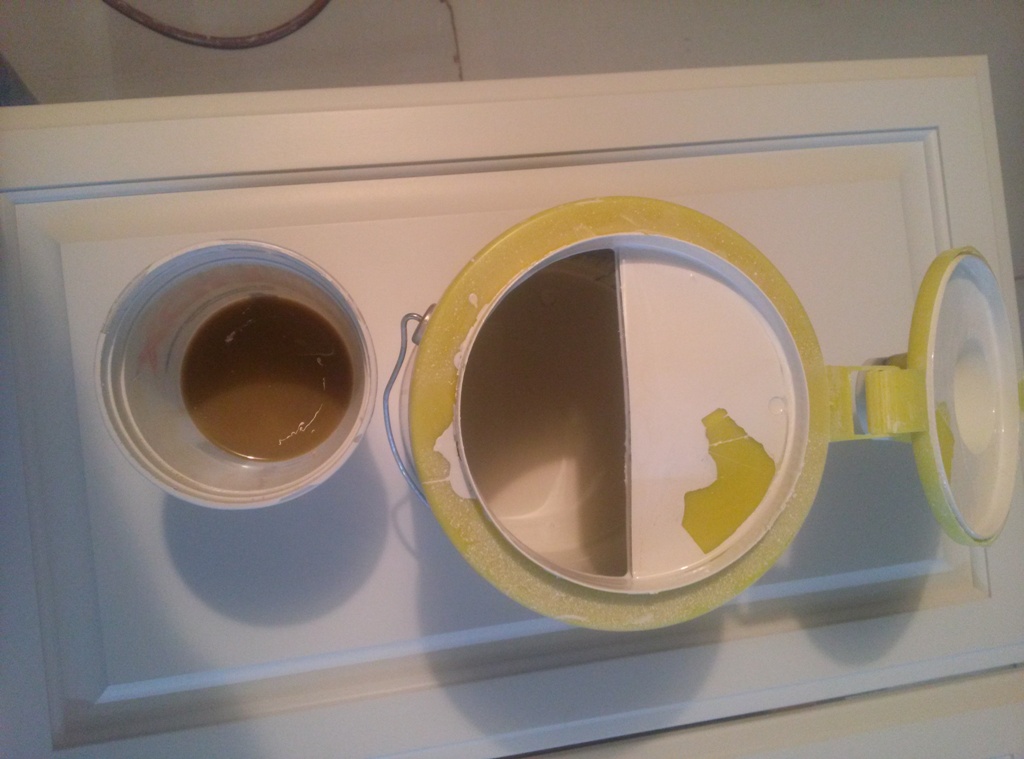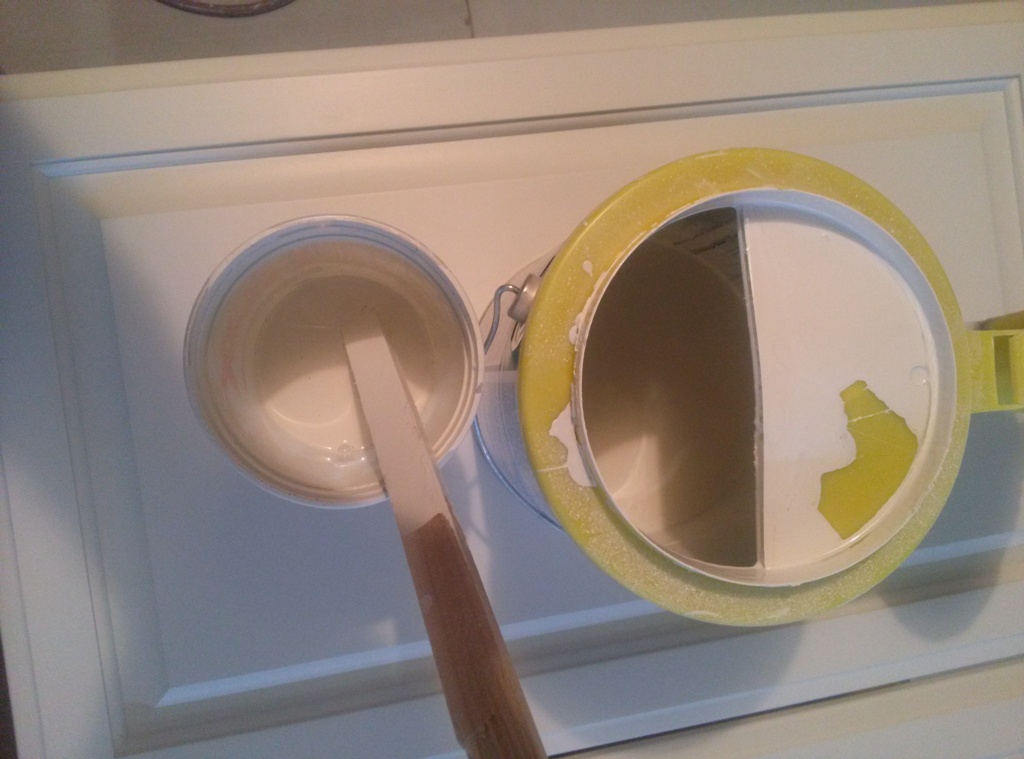I'm finishing a project with SW Pro Classic Acrylic Latex. I'm having to thin 2 parts paint with 1 part water(purified bottled water) to get it to spray out of hvlp gun with 1.4mm nozzle.
As you can see from the first picture the leftover paint in the quart cup turns brown after sitting for some time, but when re-stirred it goes back to its original color as seen in the gallon can.
Since the paint doesn't turn brown in the can, I'm assuming the addition of the water is causing this, but don't understand why and if it might possibly affect the color of the project with time.
Can anyone give me an explanation? Thanks.

From contributor Ro
I'm wondering if its just a pigment that's just floated. As long as stirring it up disperses it I'd say your OK.
From contributor St
Sure, that's probably it. I thought that, but it wasn't rising to the top in the can. Thinning it out must have allowed for the pigments to rise. Thanks for responding.
From contributor ri
That's a lot of water. I thought they limited it to 10% thinning? I'd place a call to SW before you do much more.
From contributor ni
in jeff jewitt's book he says for one quart of paint you add 3 oz. of water and 3 oz. of floetrol in a 1 qt. mixing cup and stir then add paint to the one qt. mark and stir.
paint should be sprayed with a 2.2 to 2.5 mm tip for a gravity gun.
nicko
From contributor Ma
Id agree that your trying to make the material fit your tip and you should be making the tip fit your material. Thats a lot of reducing. Likely a mistake.
From contributor St
I switched to a gun with 1.8mm tip and the paint flowed out better, but still needed approx. 33% reduction, 8oz water to 16oz paint in quart cup. I didn't have any floetrol on hand.
I didn't think this was an issue as I have seen quite a few post on these threads advocating reducing product up to 40% to get it to flow out of an hvlp setup. Of course this was also the reason for my original post as I wondered if the excessive thinning could negatively affect the performance of the paint in regards to color, adhesion, durability, etc., etc.
At 33% thinned the paint is still quite thick and not having issues with runs or sags, but having to coat more times than I'd like to build, obviously. Project looks good so far.
From my experience with them, the workers at my SW store aren't going to be able to tell me how much thinning is appropriate; they'll just tell me what I can already read on the can which says no reduction necessary and use an airless which I don't have(considering Kremlin Airmix for spraying latex in the future though.)
For those who have said this is too much water to add can you explain to me how this alters the paint's performance(other than making it less viscous), chemically speaking?
From contributor Ro
Ive always had to add a bit more water to a Latex coating than whats ( so called ) recommended. Didn't have an airless nor did I want to run it through a AAA since I don't apply much in the way of Latex.
Extra thinning might mean an extra coat but Ive never had an adhesion problem or a problem with durability.
I brushed an ICI Semi Gloss Latex on my own kitchen yearrrrrrs ago and its still as beautiful today as it was years ago when I first applied it. The sheen has held out and its easily cleaned up with soapy water. Latex is occasionally frowned upon as a finish but In happy with the end results.
From contributor De
I would recommend going to a 2.0 tip. You still probably won't get optimal results but they should be better. How big of a compressor do you have?
From contributor St
I currently have a 2hp compressor with 24gal tank and about 6cfm delivered at 40psi rated to run continuously. Using box store gravity1.4 and siphon1.8 guns. I am aware this is not an ideal set up for spraying(been a professional woodworker much longer than finisher), but has worked okay so far with thinning.
I've wanted to upgrade my set up for a while, but am going back and forth on whether I should stick with hvlp and upgrade my compressor/guns or should try airless, AAA, turbine, etc. I build custom cabinets and do interior woodwork mostly for homeowners. Typical finishes are oil or dye stain with lacquer, water or oil paint if I need to match built-ins to existing trim, and occasionally colored lacquer if I can find a store that will tint it to the color I'm trying to match.
From contributor Mi
Steven, I spray the SW proclassis latex paint probably on average 5 or 6 times each month, and I too have to over thin the paint. I also use a cup gun, and I usually have it set as a gravity fed gun. With 60 lbs pressure at my filters and a 1.8 tip, I thin a cup full with usually around 5 oz. of water. I tried the water and floetrol mix, but have never been able to tell a difference. Since floetrol is pretty thick too, I can use less thinner overall as the combination mix usually took around 8 oz.
If you like your gun set up, I would suggest getting a bigger compressor, which is always good to have for a shop. Maybe you could cut back on the thinner, if you have higher and more consistent air pressure to your gun. While I am not spraying cabinets, I have found no performance issues on our products with my thinning ratio, other than not consistently getting a silky smooth finish. Not bad, but just slightly noticeable to me, but then I am comparing it to the alkyds we spray.
From contributor ri
Steven, I've read your post #7 a couple of times. How is 8 ounces of water to 16 ounces of paint a 33% reduction? Maybe I'm not understanding something? I'm not a chemist, can't tell you how the performance of the film finish will change with over reduction. I just trust that the chemists that did formulate it, know what they are talking about. I'll ask you the same question, how do you know it won't hurt? Sure it may still look like paint with over reduction, but the chemists are working to specific parameters for flexibility, resistance to abrasion while scrubbing, stain resistance, etc.....
From contributor St
The SW ProClassic Acrylic Latex enamel contains 31% solids by volume. 16 oz of paint mixed with 8 oz of water gives me a solution with 21% solids by volume if my math is correct. Correct me if my math is wrong, but that's approx. a 33% reduction in solids by volume. Actually the reason I said 33% was simply to convey that I was mixing up 24oz of material and 8oz of it was water(8/24=.33). Not really the point of my post anyway, and to answer your question, No, I don't know if reducing with that much water will hurt the performance of the paint, hence my initial post.
If so, I was hoping someone knowledgeable in the chemistry of acrylic paint in general could give me a solid answer and explain how mixing too much water with the paint could have a negative effect instead of just acting as a vehicle to move the coating from the gun to the product and evaporating. I'm sure the chemists at SW are competent and have formulated a great product straight from the can, but that still doesn't answer the question I asked.
Anyway, thanks to everyone who replied so far.
From contributor Ba
That's a whole lot of water your spraying. One thing I'd be concerned with is continual grain raise and not getting a good smooth final finish. My go to tip on my gravity gun for all my WB finish is a 2.2 and I don't use it for pigmented finishes unless it's a really small project (GF products). I couldn't imagine getting enough finish through 1.4 or 1.8 you'd be there all day. You could switch to a pressure pot with minimal thinning that could pump your product or even an airless with a smaller tip and no thinning.
You may also want to consider warming the finish instead thinning so much before spraying.
From contributor De
Steven
We all start somewhere right? You sound pretty much the same as I was when I started. If you are looking for opinions I would tell you to first upgrade your compressor because you can never have too much air. Especially with you being a woodworker and the number of tools that can be used by a compressor.
You can then start with a pressure pot for spraying paints which you can get for a reasonable price and also some cup guns that I would recommend adding PPS cups with.
Down the road that would still allow you to add an AAA if you wish or to get a turbine or airless for onsite work.
I end up doing a lot of different finishes and over time have acquired 2 AAA units, a turbine, an airless and about a dozen or so cup guns for smaller runs of different colors, toners, glazes etc. The heart of everything is a 80 gallon 2 stage compressor that puts out about 30 CFM and that gives me everything I need.
Your situation may be different and another route may be better but without knowing more about your operation this is the way I would go.